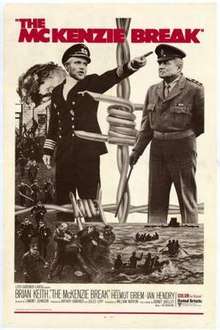The McKenzie Break
The McKenzie Break is a 1970 DeLuxe Color British war drama film directed by Lamont Johnson, starring Brian Keith as Jack Connor, an intelligence officer investigating recent disturbances at a prisoner of war (POW) camp in Scotland. The POWs are led by the charismatic and ruthless Willi Schlüter (Helmut Griem).[1]
| The McKenzie Break | |
|---|---|
 | |
| Directed by | Lamont Johnson |
| Produced by | Arthur Gardner Jules V. Levy |
| Written by | William W. Norton |
| Based on | The Bowmanville Break 1958 novel by Sidney Shelley |
| Starring | Brian Keith Helmut Griem Ian Hendry Jack Watson |
| Music by | Riz Ortolani |
| Cinematography | Michael Reed |
| Edited by | Tom Rolf |
Production company | Brighton Pictures Levy-Gardner-Laven |
| Distributed by | United Artists |
Release date |
|
Running time | 108 min. |
| Country | United Kingdom |
| Language | English / German |
Plot
At a Prisoner of War (POW) camp for Germans in the north of Scotland, Kapitän zur See Willi Schlüter (Helmut Griem) – a submariner – challenges the authority of the camp’s embattled Commanding Officer, Major Perry (Ian Hendry). British Army Captain Jack Connor arrives to investigate what's happening at the McKenzie POW Camp.
Connor believes the camp disturbances are a cover for an escape attempt. During a mass brawl two POWs escape dressed as British soldiers and Connor notices an outcast German POW named Neuchl (Horst Janson), being dragged from the barracks and fleeing from the Germans. He is badly beaten and later that night in the hospital is strangled before Connor gets the chance to learn about Schlüter's plans.
With Connor investigating the camp, Schlüter leads his 28-man escape party out of a tunnel the next day. Meeting the two escapees who have arranged a U-boat to pick them up, they all head for the coast. Unknown to Schlüter, Connor has broken the code used in letters sent by POWs to Germany and knows the plan.
Connor, along with General Kerr (Jack Watson), starts searching for the prisoners. The Germans head for the coast and burn their escape lorry, which is seen by a reconnaissance plane. Drawn by the burning lorry, Connor (now in an aircraft) locates the Germans attempting to paddle towards a surfaced U-boat at dusk. Connor calls in a Royal Navy motor torpedo boat (MTB) with depth charges to engage the U-boat. With only 50 yards to go, Connor orders the pilot to 'buzz' the inflatable dinghies, delaying Schlüter's craft, and with the MTB arriving, the U-boat dives, leaving Schlüter and three comrades stranded.
Cast
- Brian Keith as Captain Jack Connor
- Helmut Griem as Kapitän zur See Willi Schlüter
- Ian Hendry as Major Perry (Camp CO)
- Jack Watson as Major General Ben Kerr
- Patrick O'Connell as Sergeant Major Cox
- Horst Janson as Lieutenant Neuchl
- Alexander Allerson as Lieutenant Wolff
- John Abineri as Captain Kranz
- Constantine Gregory as Lieutenant Hall
- Tom Kempinski as Lieutenant Schmidt
- Eric Allan as Lieutenant Hochbauer
- Caroline Mortimer as A.T.S. Sergeant Bell
- Mary Larkin as Corporal Jean Watt
- Gregg Palmer as Lieutenant Berger
- Michael Sheard as Ingenieur-Offizier Unger
Background
The plot of the film loosely reflects real-life events at the PoW camp in Grizedale Hall, Cumbria and Bowmanville, Ontario; in particular, the interception of German attempts to communicate in code with the captured U-boat ace Otto Kretschmer, and the "trial" of Captain Rahmlow and his second-in-command, Bernhard Berndt from U-570, which was surrendered in September 1941, and recommissioned as HMS Graph. Kretschmer was also the subject of Operation Kiebitz, an attempt to liberate several U-boat commanders by submarine, from Bowmanville POW camp in Ontario, Canada, which was foiled by the Royal Canadian Navy.
Production
The film was based on the novel The Bowmanville Break by Sidney Shelley. Film rights were bought in January 1968, prior to the novel's publication, by the producing team of Jules Gardner, Arthur Levy and Arnold Laven, who ran LGL Productions and had a deal with United Artists.[2] William Norton, who had done several scripts for LGL, was assigned to write the screenplay. The location of the story was shifted from Canada to Scotland.[3]
In October 1968 Brian Keith signed to play the lead role.[4] That month the novel was published. The New York Times called it "a crackling tale".[5] "In the best tradition of escape literature," said the Chicago Tribune.[6]
In February 1969 Andre De Toth was signed to direct.[7] By April he had left the project and been replaced by Lamont Johnson. The film had been retitled The MacKenzie Break.[8]
The film was shot in Ireland, at Ardmore studios Co. Wicklow, and in Bonmahon Co. Waterford, in October 1969.[9]
References
- McKENZIE BREAK, The Monthly Film Bulletin; London Vol. 38, Iss. 444, (Jan 1, 1971): 100.
- MOVIE CALL SHEET: 'Love Bug' Set for Michele Lee Martin, Betty. Los Angeles Times 12 Jan 1968: c10.
- MOVIE CALL SHEET: John Gavin Set for Role Martin, Betty. Los Angeles Times 9 Feb 1968: c15.
- Break' Role for Keith Martin, Betty. Los Angeles Times 18 Oct 1968: f18.
- Criminals at Large By ALLEN J. HUBIN. New York Times 10 Nov 1968: BR65.
- THRILLERS Rosenzweig, A L. Chicago Tribune 29 Dec 1968: n12.
- MOVIE CALL SHEET: Israeli Actor Topol Signed for 'Fiddler' Martin, Betty. Los Angeles Times 22 Feb 1969: a7.
- MOVIE CALL SHEET: Katherine Crwford to Debut Martin, Betty. Los Angeles Times 26 Apr 1969: b7.
- The busiest film set in Europe Lennon, Peter. The Guardian 18 Oct 1969: 9.